Diego Marcos
Atomizer: Generalizing to new modalities by breaking satellite images down to a set of scalars
Jun 16, 2025Abstract:The growing number of Earth observation satellites has led to increasingly diverse remote sensing data, with varying spatial, spectral, and temporal configurations. Most existing models rely on fixed input formats and modality-specific encoders, which require retraining when new configurations are introduced, limiting their ability to generalize across modalities. We introduce Atomizer, a flexible architecture that represents remote sensing images as sets of scalars, each corresponding to a spectral band value of a pixel. Each scalar is enriched with contextual metadata (acquisition time, spatial resolution, wavelength, and bandwidth), producing an atomic representation that allows a single encoder to process arbitrary modalities without interpolation or resampling. Atomizer uses structured tokenization with Fourier features and non-uniform radial basis functions to encode content and context, and maps tokens into a latent space via cross-attention. Under modality-disjoint evaluations, Atomizer outperforms standard models and demonstrates robust performance across varying resolutions and spatial sizes.
Inherently Faithful Attention Maps for Vision Transformers
Jun 10, 2025Abstract:We introduce an attention-based method that uses learned binary attention masks to ensure that only attended image regions influence the prediction. Context can strongly affect object perception, sometimes leading to biased representations, particularly when objects appear in out-of-distribution backgrounds. At the same time, many image-level object-centric tasks require identifying relevant regions, often requiring context. To address this conundrum, we propose a two-stage framework: stage 1 processes the full image to discover object parts and identify task-relevant regions, while stage 2 leverages input attention masking to restrict its receptive field to these regions, enabling a focused analysis while filtering out potentially spurious information. Both stages are trained jointly, allowing stage 2 to refine stage 1. Extensive experiments across diverse benchmarks demonstrate that our approach significantly improves robustness against spurious correlations and out-of-distribution backgrounds.
EcoWikiRS: Learning Ecological Representation of Satellite Images from Weak Supervision with Species Observations and Wikipedia
Apr 28, 2025Abstract:The presence of species provides key insights into the ecological properties of a location such as land cover, climatic conditions or even soil properties. We propose a method to predict such ecological properties directly from remote sensing (RS) images by aligning them with species habitat descriptions. We introduce the EcoWikiRS dataset, consisting of high-resolution aerial images, the corresponding geolocated species observations, and, for each species, the textual descriptions of their habitat from Wikipedia. EcoWikiRS offers a scalable way of supervision for RS vision language models (RS-VLMs) for ecology. This is a setting with weak and noisy supervision, where, for instance, some text may describe properties that are specific only to part of the species' niche or is irrelevant to a specific image. We tackle this by proposing WINCEL, a weighted version of the InfoNCE loss. We evaluate our model on the task of ecosystem zero-shot classification by following the habitat definitions from the European Nature Information System (EUNIS). Our results show that our approach helps in understanding RS images in a more ecologically meaningful manner. The code and the dataset are available at https://github.com/eceo-epfl/EcoWikiRS.
Hybrid Phenology Modeling for Predicting Temperature Effects on Tree Dormancy
Jan 28, 2025Abstract:Biophysical models offer valuable insights into climate-phenology relationships in both natural and agricultural settings. However, there are substantial structural discrepancies across models which require site-specific recalibration, often yielding inconsistent predictions under similar climate scenarios. Machine learning methods offer data-driven solutions, but often lack interpretability and alignment with existing knowledge. We present a phenology model describing dormancy in fruit trees, integrating conventional biophysical models with a neural network to address their structural disparities. We evaluate our hybrid model in an extensive case study predicting cherry tree phenology in Japan, South Korea and Switzerland. Our approach consistently outperforms both traditional biophysical and machine learning models in predicting blooming dates across years. Additionally, the neural network's adaptability facilitates parameter learning for specific tree varieties, enabling robust generalization to new sites without site-specific recalibration. This hybrid model leverages both biophysical constraints and data-driven flexibility, offering a promising avenue for accurate and interpretable phenology modeling.
Applying the maximum entropy principle to multi-species neural networks improves species distribution models
Dec 26, 2024



Abstract:The rapid expansion of citizen science initiatives has led to a significant growth of biodiversity databases, and particularly presence-only (PO) observations. PO data are invaluable for understanding species distributions and their dynamics, but their use in Species Distribution Models (SDM) is curtailed by sampling biases and the lack of information on absences. Poisson point processes are widely used for SDMs, with Maxent being one of the most popular methods. Maxent maximises the entropy of a probability distribution across sites as a function of predefined transformations of environmental variables, called features. In contrast, neural networks and deep learning have emerged as a promising technique for automatic feature extraction from complex input variables. In this paper, we propose DeepMaxent, which harnesses neural networks to automatically learn shared features among species, using the maximum entropy principle. To do so, it employs a normalised Poisson loss where for each species, presence probabilities across sites are modelled by a neural network. We evaluate DeepMaxent on a benchmark dataset known for its spatial sampling biases, using PO data for calibration and presence-absence (PA) data for validation across six regions with different biological groups and environmental covariates. Our results indicate that DeepMaxent improves model performance over Maxent and other state-of-the-art SDMs across regions and taxonomic groups. The method performs particularly well in regions of uneven sampling, demonstrating substantial potential to improve species distribution modelling. The method opens the possibility to learn more robust environmental features predicting jointly many species and scales to arbitrary large numbers of sites without an increased memory demand.
SenCLIP: Enhancing zero-shot land-use mapping for Sentinel-2 with ground-level prompting
Dec 11, 2024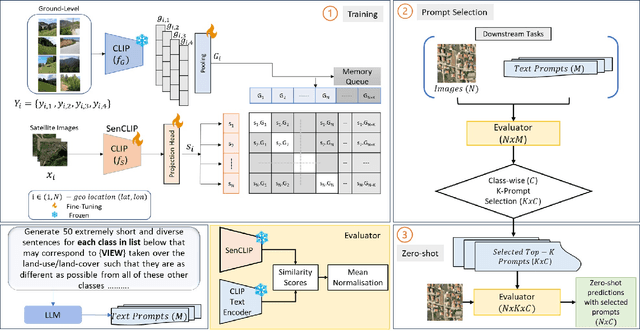
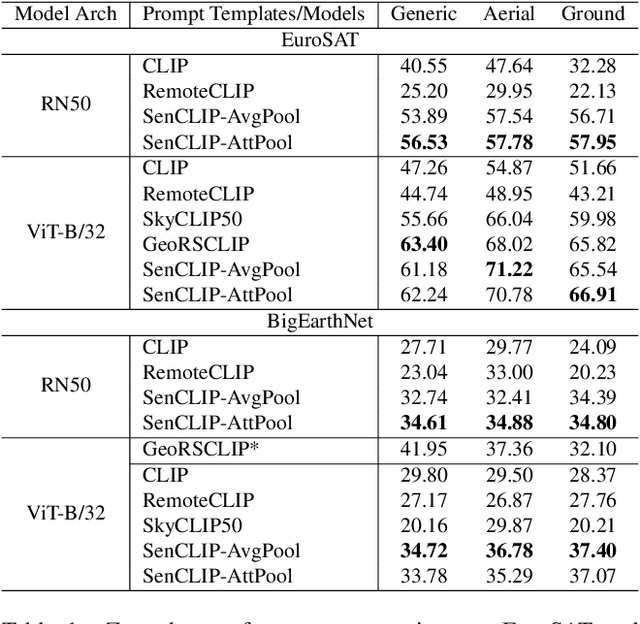

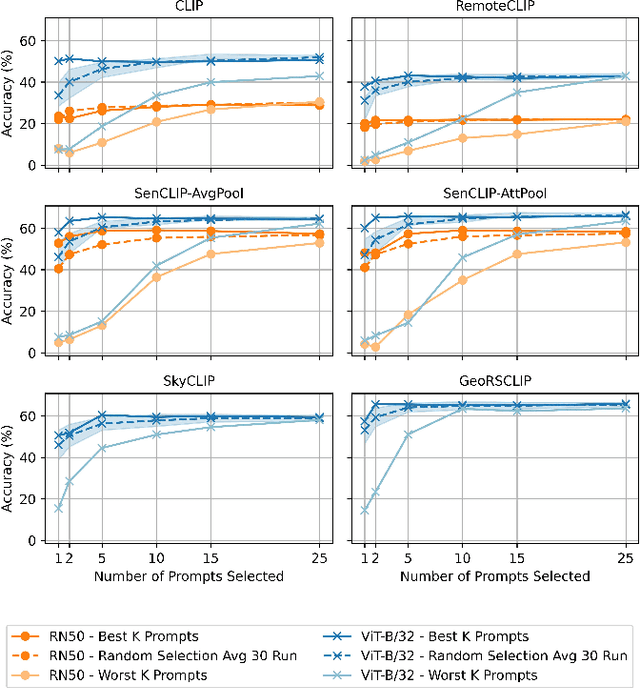
Abstract:Pre-trained vision-language models (VLMs), such as CLIP, demonstrate impressive zero-shot classification capabilities with free-form prompts and even show some generalization in specialized domains. However, their performance on satellite imagery is limited due to the underrepresentation of such data in their training sets, which predominantly consist of ground-level images. Existing prompting techniques for satellite imagery are often restricted to generic phrases like a satellite image of ..., limiting their effectiveness for zero-shot land-use and land-cover (LULC) mapping. To address these challenges, we introduce SenCLIP, which transfers CLIPs representation to Sentinel-2 imagery by leveraging a large dataset of Sentinel-2 images paired with geotagged ground-level photos from across Europe. We evaluate SenCLIP alongside other SOTA remote sensing VLMs on zero-shot LULC mapping tasks using the EuroSAT and BigEarthNet datasets with both aerial and ground-level prompting styles. Our approach, which aligns ground-level representations with satellite imagery, demonstrates significant improvements in classification accuracy across both prompt styles, opening new possibilities for applying free-form textual descriptions in zero-shot LULC mapping.
Multi-Scale Grouped Prototypes for Interpretable Semantic Segmentation
Sep 14, 2024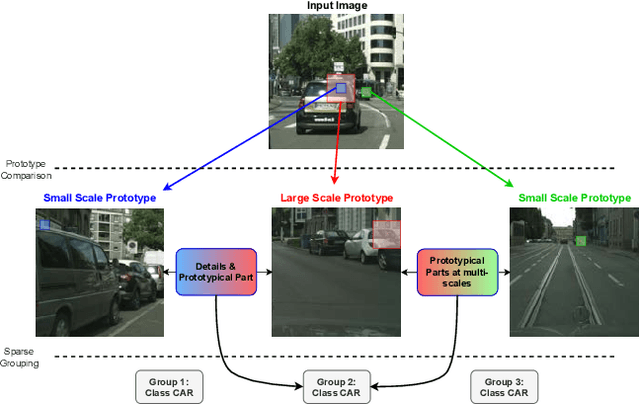

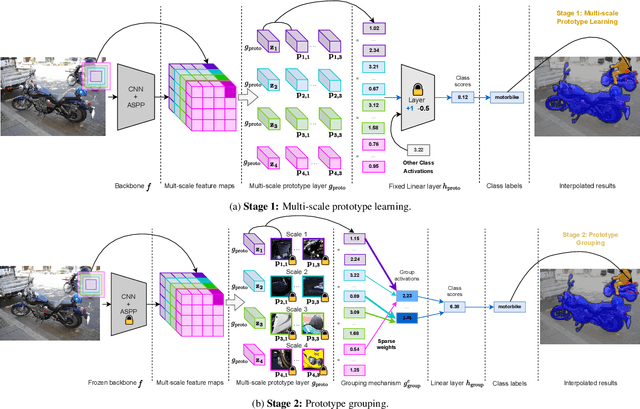

Abstract:Prototypical part learning is emerging as a promising approach for making semantic segmentation interpretable. The model selects real patches seen during training as prototypes and constructs the dense prediction map based on the similarity between parts of the test image and the prototypes. This improves interpretability since the user can inspect the link between the predicted output and the patterns learned by the model in terms of prototypical information. In this paper, we propose a method for interpretable semantic segmentation that leverages multi-scale image representation for prototypical part learning. First, we introduce a prototype layer that explicitly learns diverse prototypical parts at several scales, leading to multi-scale representations in the prototype activation output. Then, we propose a sparse grouping mechanism that produces multi-scale sparse groups of these scale-specific prototypical parts. This provides a deeper understanding of the interactions between multi-scale object representations while enhancing the interpretability of the segmentation model. The experiments conducted on Pascal VOC, Cityscapes, and ADE20K demonstrate that the proposed method increases model sparsity, improves interpretability over existing prototype-based methods, and narrows the performance gap with the non-interpretable counterpart models. Code is available at github.com/eceo-epfl/ScaleProtoSeg.
GeoPlant: Spatial Plant Species Prediction Dataset
Aug 25, 2024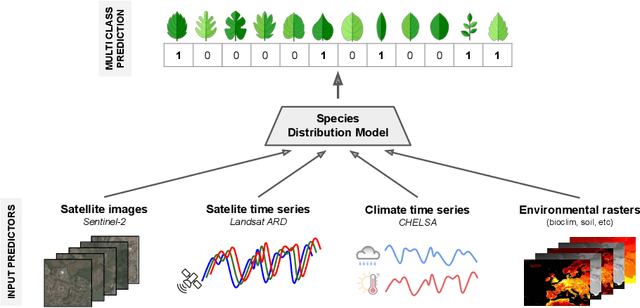
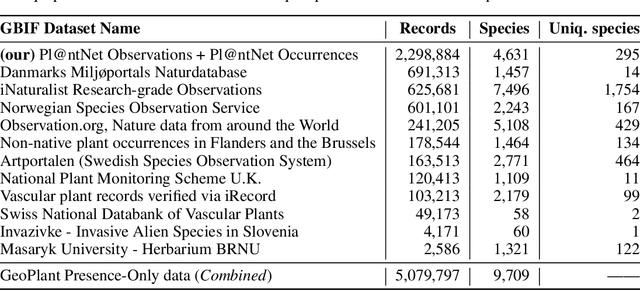
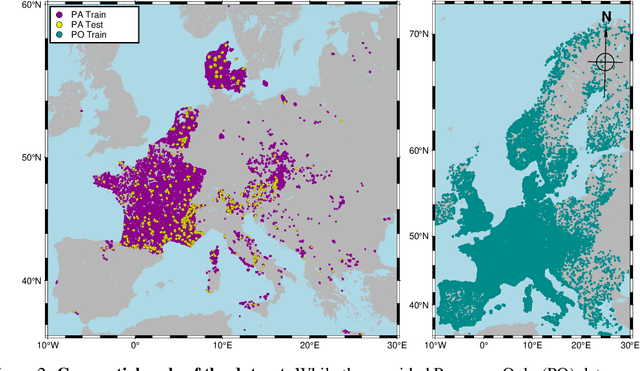

Abstract:The difficulty of monitoring biodiversity at fine scales and over large areas limits ecological knowledge and conservation efforts. To fill this gap, Species Distribution Models (SDMs) predict species across space from spatially explicit features. Yet, they face the challenge of integrating the rich but heterogeneous data made available over the past decade, notably millions of opportunistic species observations and standardized surveys, as well as multi-modal remote sensing data. In light of that, we have designed and developed a new European-scale dataset for SDMs at high spatial resolution (10-50 m), including more than 10k species (i.e., most of the European flora). The dataset comprises 5M heterogeneous Presence-Only records and 90k exhaustive Presence-Absence survey records, all accompanied by diverse environmental rasters (e.g., elevation, human footprint, and soil) that are traditionally used in SDMs. In addition, it provides Sentinel-2 RGB and NIR satellite images with 10 m resolution, a 20-year time-series of climatic variables, and satellite time-series from the Landsat program. In addition to the data, we provide an openly accessible SDM benchmark (hosted on Kaggle), which has already attracted an active community and a set of strong baselines for single predictor/modality and multimodal approaches. All resources, e.g., the dataset, pre-trained models, and baseline methods (in the form of notebooks), are available on Kaggle, allowing one to start with our dataset literally with two mouse clicks.
PDiscoFormer: Relaxing Part Discovery Constraints with Vision Transformers
Jul 05, 2024Abstract:Computer vision methods that explicitly detect object parts and reason on them are a step towards inherently interpretable models. Existing approaches that perform part discovery driven by a fine-grained classification task make very restrictive assumptions on the geometric properties of the discovered parts; they should be small and compact. Although this prior is useful in some cases, in this paper we show that pre-trained transformer-based vision models, such as self-supervised DINOv2 ViT, enable the relaxation of these constraints. In particular, we find that a total variation (TV) prior, which allows for multiple connected components of any size, substantially outperforms previous work. We test our approach on three fine-grained classification benchmarks: CUB, PartImageNet and Oxford Flowers, and compare our results to previously published methods as well as a re-implementation of the state-of-the-art method PDiscoNet with a transformer-based backbone. We consistently obtain substantial improvements across the board, both on part discovery metrics and the downstream classification task, showing that the strong inductive biases in self-supervised ViT models require to rethink the geometric priors that can be used for unsupervised part discovery.
Contrastive Pretraining for Visual Concept Explanations of Socioeconomic Outcomes
Apr 15, 2024



Abstract:Predicting socioeconomic indicators from satellite imagery with deep learning has become an increasingly popular research direction. Post-hoc concept-based explanations can be an important step towards broader adoption of these models in policy-making as they enable the interpretation of socioeconomic outcomes based on visual concepts that are intuitive to humans. In this paper, we study the interplay between representation learning using an additional task-specific contrastive loss and post-hoc concept explainability for socioeconomic studies. Our results on two different geographical locations and tasks indicate that the task-specific pretraining imposes a continuous ordering of the latent space embeddings according to the socioeconomic outcomes. This improves the model's interpretability as it enables the latent space of the model to associate urban concepts with continuous intervals of socioeconomic outcomes. Further, we illustrate how analyzing the model's conceptual sensitivity for the intervals of socioeconomic outcomes can shed light on new insights for urban studies.
 Add to Chrome
Add to Chrome Add to Firefox
Add to Firefox Add to Edge
Add to Edge